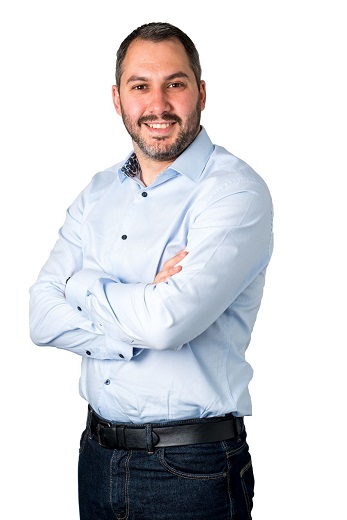
Mike Muldoon, Alstom
Could you envisage hydrogen being a key fuel source for the rail industry within the next 10 years?
Yes, hydrogen will be a key fuel source for the rail industry, growing in the extent of its use throughout the decade. The Traction Decarbonisation Network Strategy produced by Network Rail clearly indicates the requirement for hydrogen in the UK and Alstom’s various hydrogen fleet orders in Europe reflect the necessity for hydrogen to start replacing diesel and complement electrification of the core and most heavily used routes today. It is far harder to envisage rail in 10 years’ time without hydrogen.
Can you tell us about your career so far in the rail industry?
I graduated as an Industrial Designer in 1989 and spent 13 years designing the human interfaces of trains, their interiors and driver environments, and their exterior design. Through the noughties I worked for various UK clients managing complex projects culminating in the retro-fitment of the TBTC signalling systems on Jubilee and Northern Line fleets for Alstom. In 2010 I joined Alstom as UK Services Tenders Director. Various commercial roles then led to me becoming Head of Business Development in 2017 with the remit to consider new technologies and applications for the UK and Ireland.
Besides the work you’re involved with at Alstom, what other innovations excite you from the wider rail industry?
Most exciting is the space that we need to innovate in. We must make rail the most sustainable way to travel, redefining public perceptions and attracting to our network people who never travelled with us before. As we build back from the pandemic we may have lost some of our previous customers but we can recover and grow by attracting new customers. Innovation that achieves this could range from hygiene and safety measures like air filtration and automated cleaning right through to digitally enabled, smarter trains. Every passenger that moves from their car to the train is decarbonisation in action.
How important is industry wide collaboration in driving innovation across the UK railway?
Collaboration is key. Products must support the services operators wish to offer. Those services must be integrated seamlessly practically and technically. As a market leader, Alstom has a wide portfolio of products and services that we can build upon to drive further innovation to deliver the changes we need to maximise the benefit of the railway to UK plc. We also recognise the need to collaborate beyond the rail industry, to consider cross-sectoral opportunities, such as for alternative energy sources and to facilitate better end to end and multi-modal journeys for rail passengers.
Read the post where Mike's work features
Emily Kent, One Big Circle

Can you tell us about your career so far in the rail industry?
We've been involved in the rail industry for less than two years having previously delivered video solutions and CCTV systems in highways and in sports broadcasting. The move into rail came when we were looking for new opportunities to apply our intelligent video expertise and the industry showed very early interest in what we were creating with AIVR. I'm very much a newcomer but have met so many passionate people (both at events when we could, and then online) and have learnt so much about rail already (a lot of TLAs - Three Letter Acronyms - for one!) that I'm excited every day about what we can help the industry achieve.
Over the last 18 months the rate of engagement and progress we've witnessed and been involved in is real testament to the appetite the industry has for working progressively and increasingly openly. Being a part of the RIA community too has been a huge part of that. We now have direct contracts with Network Rail and Transport for Wales across all routes and regions and also with multiple organisations, from Tier 1 to SMEs in the wider supply chain, so we certainly feel innovative solutions and SMEs have a seat at the table.
Besides the work you’re involved with at One Big Circle, what other innovations excite you from the wider rail industry?
As a daily rail commuter I'm personally excited about the innovations in passenger experience and connectivity, especially as the outcomes of Williams start to impact positively. Having more control over my own journey times, costs and environment and the potential of interoperability as travel opportunities widen again is exciting. And with my OBC hat on I love seeing how what we do to support infrastructure monitoring and maintenance directly affects the efficiency of the network and filters through the wider industry.
How important is industry wide collaboration in driving innovation across the UK railway?
Collaboration and openness ensures that the right challenges are being addressed at the right time with the right teams working together from across the supply chain, developing those much needed solutions. This ensures innovation meets those critical challenges and is fit for purpose. It really has to start with those open and honest conversations about what is needed and how it can be achieved in a more agile, collaborative and iterative way. No one can deliver the Digital Railway on their own, for example, so as reliance on data increases it's critical that all of those systems and sources can interface with each other rather than remaining siloed - and that needs industry wide collaboration. Having that 'doing by trying' or 'fail fast' attitude is how we get things done, and then the results start to improve and take effect much more rapidly. When the benefits are seen in practice rather than in theory you get real engagement and progress.
Read the post where Emily's work features

Darren O'Brien, Southeastern
Can you tell us about your career so far in the rail industry?
I spent five years working as a ticket office clerk at Irish Rail before moving to the UK where I was employed by Southeastern as a Duty Station Manager in 2015. I worked as a Station Manager in various locations and covered the role of Station Change Manager for the rebuild of London Bridge Station (Thameslink Programme). I am now employed as a Retail Systems and Contracts Manager where I manage contacts for some of the retail services provided to our passengers.
What’s the biggest learning you’ll take away from launching the Rail to Refuge in terms of the rail industry’s role in supporting society?
My biggest learning from the launch of the Rail to Refuge scheme is to follow through on your ideas as the right support can not only help champion good causes but bring about positive changes for those in our communities who do not always ask for help but who need it.
Besides the work you’re involved with Rail to Refuge what other innovations excite you from the wider rail industry?
The railway is constantly evolving with advances in technology which is always interesting. However, I am more of a people person so it is very motivational to see work being done to create greater awareness of non-visible disabilities as well as more focus being placed on Health and Well-being (Mental Health awareness) within the railway. This helps us to better understand our passengers, colleagues and other persons we come into contact with on a daily basis.
How important is industry wide collaboration in driving innovation across the UK railway?
Industry wide collaboration is critical to the success in driving innovation across the UK railway as we can all learn what works well, how to implement change smoothly as well as learn from each other’s mistakes and in some instance can help reduce costs.
Read the post where Mike's work features
Colin Johnson, D/Gauge

Can you tell us about your career so far in the rail industry?
Before I joined, D/Gauge was primarily a research outfit (founded by my father, David Johnson) investigating new gauging methods and pantograph gauging standards. I joined D/Gauge in early 2012 (technically as the second employee) to develop a consultancy business. The Railway has always been part of my extended family, as my parents were influential with working with the PWI and creating ground-breaking software innovations – something which I am proud to continue doing today.
We started out by supporting critical areas of the Great Western Electrification and the introduction of the IEP. Our business has grown to a 20 strong organisation, supporting approximately 50% of the ongoing vehicle introductions and multiple major infrastructure schemes in the UK. My role now is to support the various team leaders, develop partnerships with other companies and lead our business development effort.
How much of a change does gauging software have on cost efficiency?
Gauging assessment is only as good as the input data, and over the years this has become a bigger and time-consuming challenge. Our approach of centralising data will have a direct improvement on assessment times – feedback we have received says that D/Gauge Rift saves many hours of setup. We worked hard with development partners and beta customers to spend time analysing where there are costly delays in the process and use the power of software to reduce these. In our field, our engineers time is money, and the new D/Gauge Rift software directly reduces the amount of time taken to carry out the process from end to end.
Likewise, the standards which govern our railway can be difficult to interpret for specific scenarios. By locating the assessment to a specific asset, we save the user significant time (many hours, in-fact) in post-processing the results using the location specific rules. I think our industry will benefit from more standardisation of outputs, to reduce 3rd party confusion when they are reviewing gauging findings. This is something which I believe D/Gauge is most equipped for. Our longstanding history of involvement with setting and reviewing gauging standards for a safer railway means we have excellent working relationships with the industry. A homogenised gauging report across the industry will not only help us to identify areas of concern but speed up the length of time each review takes. It’s game-changing.
Besides the work you’re involved with at D/Gauge, what other innovations excite you from the wider rail industry?
I’m a big fan of home automation and connectivity, and how technology can enhance or speed up life processes. What were initially considered gadgets I suppose have quickly earned their place as essential technology. The very best ones focus on the problem they are trying to solve. Sometimes in the rail industry, when we think innovation, we are often still too focussed on the way we solve the problem, not defining the problem itself.
One of the very exciting innovations which is close to my heart is the capability of data scanning. LiDAR has increased the number of data points available and given us truly X-Ray vision of the network -which is fascinating. I hope to see AI take some leaps too, in assisting to refine the data points and helping to make decisions. Increased data means that gauging software needs to be able to efficiently utilise this data, so D/Gauge Rift’s performance capabilities are unparallel with this in mind.
How important is industry wide collaboration in driving innovation across the UK railway?
To innovate well (i.e. get it adopted) you need the right stakeholders, cheerleaders, development team and first adopters. This is the reason why I think the best innovation is delivered by a range of organisations, and of course they need to collaborate, which in my opinion is about being completely aligned. For me, collaboration is the key to the adoption of innovation. When ground-breaking innovation is delivered – the whole industry will benefit, so it is in everyone’s best interests to collaborate for a better outcome. That’s one of the great things about innovation, it is for the source cause with everyone working to solve the same problems.
Read the post where Colin's work features